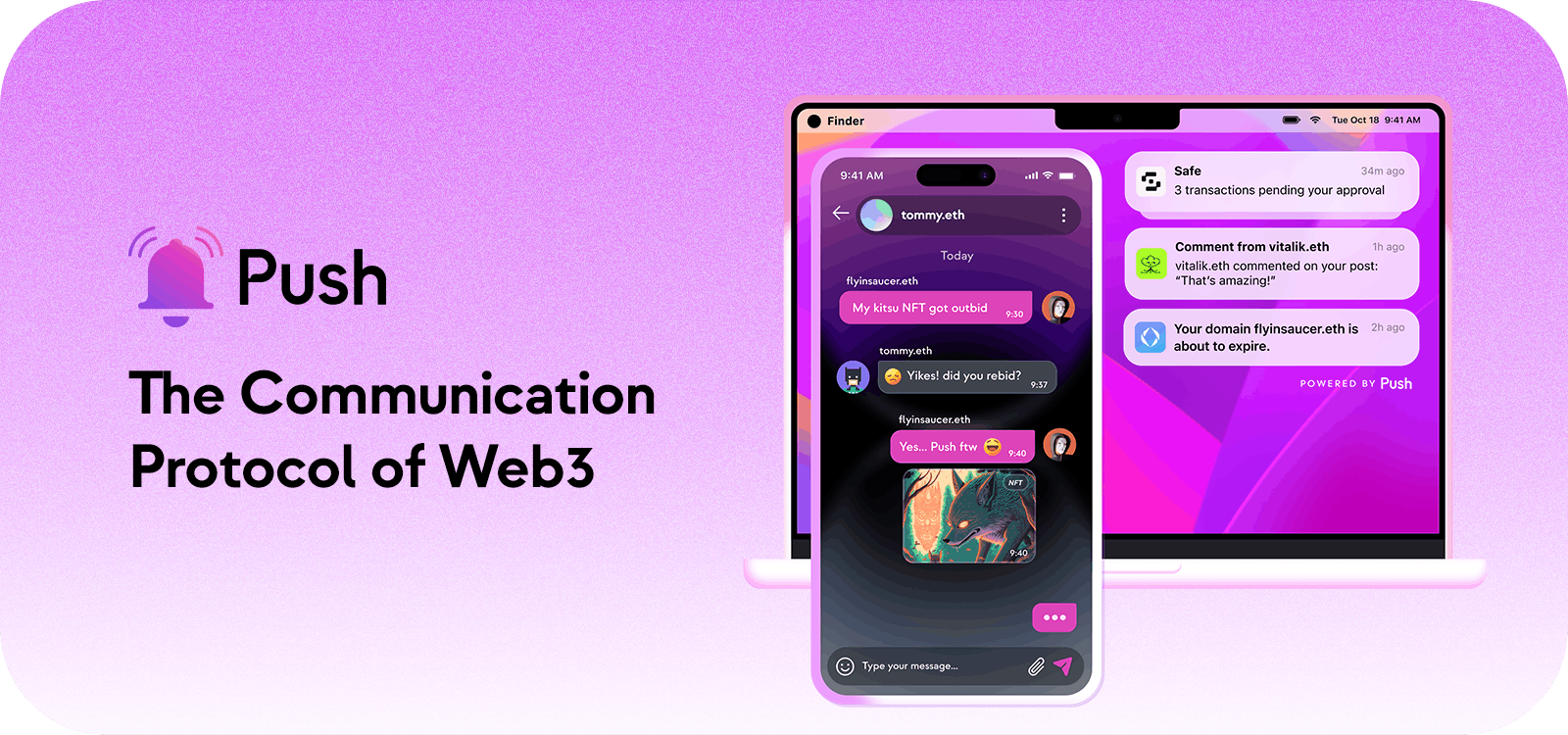Push Protocol: Revolutionizing Decentralized Communication in Web3
Introduction
In the dynamic landscape of Web3, efficient and decentralized communication is pivotal. Enter Push Protocol, an innovative decentralized communication protocol poised to redefine how we exchange notifications and messages within the Web3 ecosystem. In this tech blog, we will delve into the core aspects of Push Protocol, from its key features to practical applications, offering valuable insights for developers and enthusiasts.
The Power of Push Protocol
Streamlined Web3 Notifications
Push Protocol provides a seamless mechanism for sending and receiving notifications and messages across users, decentralized applications (dApps), and Web3 services. It leverages blockchain technology to guarantee secure, transparent, and efficient communication.
Advantages Of Traditional Push Notification Systems
Push Protocol distinguishes itself from traditional push notification systems in the following ways:
Decentralized Foundation: Unlike centralized notification systems, Push Protocol operates on a decentralized network, mitigating data breach and censorship risks. Users retain greater control over their communications.
Cross-Chain Compatibility: Push Protocol is engineered for cross-blockchain functionality, fostering interoperability among diverse Web3 platforms. This interoperability is essential in the fragmented blockchain landscape.
Scalability: Thanks to its decentralized architecture and innovative consensus mechanisms, Push Protocol scales seamlessly to meet the burgeoning demands of Web3 applications and services.
Security: Push Protocol employs robust encryption and cryptographic techniques to ensure message privacy and security. Users can trust the integrity and confidentiality of their communications.
Getting Started with Push Protocol
To embark on your Push Protocol journey, follow these steps:
Development Environment Setup: Install necessary development tools, including a suitable IDE, and ensure access to a blockchain environment for testing.
Library Installation: Obtain Push Protocol libraries and dependencies tailored to your chosen programming language or platform. Comprehensive installation instructions are available in the official documentation.
Access Documentation and Resources: Explore the comprehensive documentation and resources accessible on the Push Protocol website. These resources furnish the information required for seamless Push Protocol integration into your projects.
Key Features of Push Protocol
Cross-Chain Compatibility
Push Protocol's capability to function seamlessly across multiple blockchain networks renders it a versatile choice for Web3 applications spanning different platforms.
Decentralized Architecture
The decentralized architecture ensures that no single entity possesses control over the communication network, bolstering security and reliability.
Scalability
Push Protocol's innovative consensus mechanisms empower it to scale efficiently, even amidst escalating demand, making it ideal for high-traffic dApps and services.
Security
Push Protocol deploys advanced encryption techniques to safeguard messages, guaranteeing the confidentiality and tamper resistance of sensitive data.
Code Examples
To gain a better grasp of Push Protocol, consider these simplified code snippets in a popular programming language. These examples illustrate how to send notifications using the Push Protocol:
1. Sending Notifications
import push_protocol
# Initialize Push Protocol
push = push_protocol.PushClient()
# Send a notification
message = "Hello, Web3!"
recipient = "0xrecipient_address"
push.send_notification(message, recipient)
2. Receiving Notifications
import push_protocol
# Initialize Push Protocol client
push = push_protocol.PushClient()
# Simulate a user's address
user_address = "0xuser_address"
# Check for incoming notifications
notifications = push.get_notifications(user_address)
# Process notifications
for notification in notifications:
print(f"Received notification: {notification['message']} from {notification['sender']}")
3. Cross-Chain Notification
import push_protocol
# Initialize Push Protocol clients for different blockchains
ethereum_push = push_protocol.PushClient(blockchain="Ethereum")
bsc_push = push_protocol.PushClient(blockchain="Binance Smart Chain")
# Simulate user addresses on different chains
ethereum_user = "0xethereum_user_address"
bsc_user = "0xbsc_user_address"
# Send cross-chain notification
message = "Hello from Ethereum to BSC!"
ethereum_push.send_notification(message, bsc_user)
4. Priority Notifications
import push_protocol
# Initialize Push Protocol client
push = push_protocol.PushClient()
# Simulate a user's address
user_address = "0xuser_address"
# Send a high-priority notification
message = "URGENT: Your transaction is confirmed!"
push.send_notification(message, user_address, priority="high")
5. Notification Channels
import push_protocol
# Initialize Push Protocol client
push = push_protocol.PushClient()
# Simulate a user's email address
user_email = "user@example.com"
# Send a notification via email
message = "Check out our latest updates!"
push.send_notification(message, user_email, channel="email")
These code examples showcase different use cases and features of Push Protocol, from receiving notifications to utilizing priority settings, cross-chain compatibility, and notification channels. Developers can adapt these examples to suit their specific application requirements.

Real-World Use Cases
Push Protocol finds application across various domains in the Web3 space:
DeFi: In decentralized finance, Push Protocol can transmit alerts for price changes, liquidation warnings, and yield farming opportunities.
Gaming: Gaming dApps can harness Push Protocol for in-game notifications, updates, and multiplayer interactions.
Social Media: Web3 social media platforms can employ Push Protocol for real-time engagement, such as comments, likes, and direct messaging.
Integration Tips
For seamless Push Protocol integration into your project, heed these tips:
Select the Appropriate Notification Channels: Thoughtfully choose notification channels (email, push notifications, SMS) based on project requirements and user preferences.
Optimize Performance: Implement caching and prioritize critical messages to enhance communication system performance.
Error Handling: Develop robust error-handling mechanisms to ensure reliable message delivery, even in adverse network conditions.
Technical Insights
Push Protocol's underlying technology hinges on blockchain-based consensus mechanisms and smart contracts, enabling secure and decentralized communication. Developers keen on technical details can delve into the protocol's whitepaper and GitHub repository for a deeper understanding.
Challenges and Solutions
While integrating Push Protocol, you may encounter scalability and compatibility challenges. To mitigate these issues, consider implementing layer 2 scaling solutions and staying updated with protocol enhancements.
Conclusion
Push Protocol marks a significant stride in decentralized communication for Web3. Its cross-chain compatibility, decentralized architecture, scalability, and security features position it as a transformative force in the blockchain realm. By adhering to provided guidelines and best practices, developers can unlock the full potential of Push Protocol, ushering in a new era of secure and efficient communication in Web3 applications and services. As Web3 continues to evolve, Push Protocol is poised to be a pivotal player, elevating user experiences and fostering innovation in the decentralized domain.